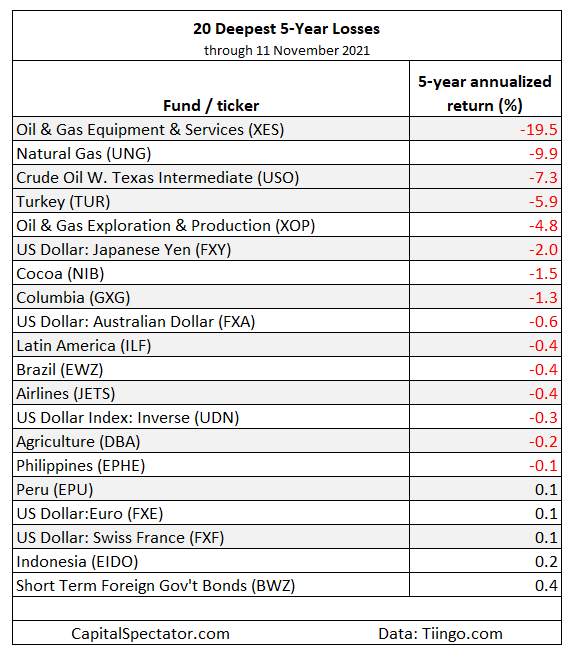Energy stocks and commodities have rallied sharply this year but remain on the short list for our deep-value list, based on relative rankings for a set of nearly 150 ETFs.
To be sure, the depth of the estimated value premium has faded from previous updates regarding energy shares and commodities—see this December 2020 edition, for instance. The crowd has since bid up prices of some corners of energy and raw materials, but the rebound still looks modest in some cases relative to the rest of the major asset classes.
Before we dive into the numbers, a quick recap of how we’re defining “value.” The metric used in this column is the 5-year return, which is based on an idea outlined in a paper by AQR Capital Management’s Cliff Asness and two co-authors: “Value and Momentum Everywhere,” published in a 2013 issue of the Journal of Finance. There are numerous value metrics and so no one should confuse the 5-year-performance benchmark as the definitive measure of bargain-priced assets. But as a starting point in the process of identifying where the crowd’s expectations have stumbled (or at least lag in relative terms), the 5-year change has some appeal.
One advantage of using a 5-year performance measure: It can be applied over a broad set of assets, thereby leveling the playing field for evaluating this risk factor. Another plus: the methodology is simple and intuitive, all but eliminating estimation risk, which can complicate accounting-based value gauges, such as price-to-book and price-to-earnings measures. In short, the 5-year return is a handy tool as a first approximation for identifying ETFs that appear to be deeply discounted by the crowd, which may indicate relatively high expected returns via the value proposition for investing.
As always, there are no guarantees that the so-called value premium, no matter the definition, will generate superior performance anytime soon, if ever. Recent history certainly leaves plenty of room for doubt, offset at times with periods of encouragement. The good news: kicking the tires is always a risk-free proposition.
The ranking below covers 146 exchange-traded products that run the gamut: US and foreign stocks, bonds, real estate, commodities and currencies. You can find the full list here, sorted in ascending order by annualized 5-year return—1260 trading days—through Thursday's close (Nov. 11, 2021).
As a starting point, let’s rank the major asset classes. The first takeaway: red ink has faded from the list. The weakest performer, which implies the deepest value in relative terms: bonds in emerging markets [VanEck J.P. Morgan EM Local Currency Bond ETF (NYSE:EMLC)]. By contrast, the top anti-value candidate: US stocks via Vanguard Total Stock Market Index Fund ETF Shares (NYSE:VTI).

Ranking the deepest value candidates for the full list continues to show a slice of the energy sector) deep in the hole: oil and gas equipment services via SPDR® S&P Oil & Gas Equipment & Services ETF (NYSE:XES). Despite the hefty loss over the trailing 5-year window, XES has run higher this year: the ETF is up 29.2% year-to-date, modestly above the broad stock market’s gain via the SPDR® S&P 500 (NYSE:SPY). The depth of XES’s 5-year loss suggests there’s more upside to go—assuming, of course, you adhere to the value proposition as defined by 5-year results.

